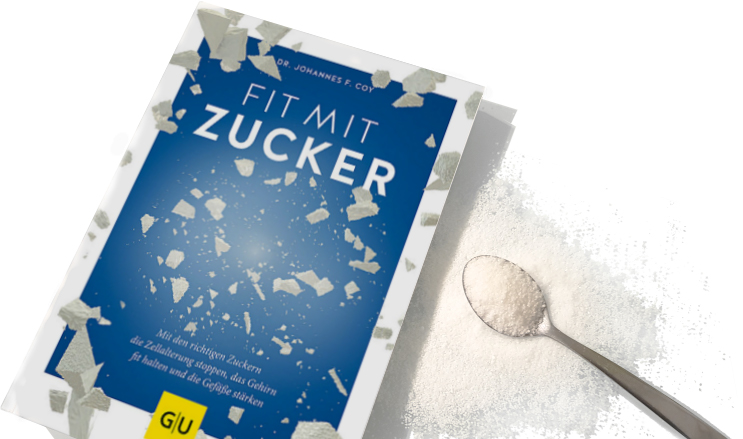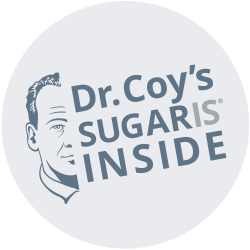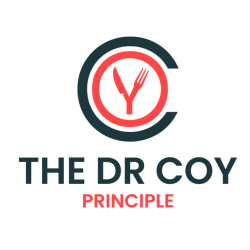Learn more about Dr. Coy and the creation of his sugar solutions.
Dr Johannes Coy is a world-renowned scientist whose research focuses on the health benefits of sugar awareness. Dr Coy has made a number of important genetic discoveries which change our understanding of cancer and nutrition and make him the leading expert on sugars.

Book: Fit with Sugar, by Dr Johannes Coy
Dr Coy has written several books about cancer nutrition. His latest book, Fit with Sugar, is now available. In this book, you’ll discover the evolutionary role of sugar in the human body. Consuming too much conventional sugar isn’t good for our health, but with the right sugars, we can stop cell ageing, keep the brain fit, protect against diseases and switch on fat burning. Find out how you can maintain physical and mental performance using natural low- glycaemic sugars and sugar substitutes. The book includes many delicious recipes for cakes, snacks and desserts, so you can implement a sugar-conscious diet easily and intelligently, without giving up sweet treats.
Buy the book: Cancer-Fighting Diet: Diet and Nutrition Strategies to Help Weaken Cancer Cells and Improve Treatment, by Dr Johannes Coy.
Research & Resources
Unveiling the impact of allulose on oral microbiota and biofilm formation via a cariogenic potential assessment platform
This study examined how allulose affects oral bacteria and biofilm formation compared to common sugars like sucrose, glucose, and fructose. Using in vitro models ranging from single bacteria to complex saliva-derived communities, researchers found that allulose led to lower bacterial growth, reduced acid production, and weaker biofilm structures. It also helped maintain greater microbial diversity and more beneficial bacteria. Overall, allulose appeared far less cariogenic than traditional sugars, suggesting it could support better oral health, though further in vivo studies are needed to confirm these results.
High Sugar-Sweetened Beverage Intake and Oral Cavity Cancer in Smoking and Nonsmoking Women
This study examines the relationship between sugar-sweetened beverage (SSB) consumption and the risk of developing oral cavity cancer in women. Researchers analysed long-term data and found that women who consumed higher amounts of SSBs had a significantly greater risk of developing oral cancer compared to those who consumed less. The findings highlight a potential dietary risk factor for oral cavity cancer and suggest that reducing intake of sugary drinks may be a practical and effective step toward lowering cancer risk in women. This adds to the growing body of evidence linking high sugar consumption to various forms of cancer.
D-Tagatose: A Rare Sugar with Functional Properties and Antimicrobial Potential against Oral Species
D-tagatose, a low-calorie rare sugar, offers significant health benefits, particularly for oral health. With antioxidant and prebiotic properties, it has a low glycaemic impact, supports lipid profile improvement, and shows potential in managing diabetes and obesity. Studies highlight its antibacterial effects, including reducing cariogenic bacteria like S. mutans, inhibiting biofilm formation, and preventing pH decline. D-tagatose also promotes oxidative stress reduction and demonstrates effectiveness as an air-polishing powder for biofilm removal. These attributes position D-tagatose as a promising alternative sugar for preventing systemic diseases and enhancing oral health.
Synbiotic impact of tagatose on viability of Lactobacillus rhamnosus strain GG mediated by the phosphotransferase system (PTS)
Synbiotics, the combination of prebiotics and probiotics, has been shown to produce synergistic effects that promote gastrointestinal well-being of host. Tagatose is a low calorie food ingredient with putative health-promoting benefits. Herein, we investigated its synbiotic impact on the viability of Lactobacillus casei 01 and Lactobacillus rhamnosus strain GG and the potential mechanism involved. Tagatose, as a synbiotic substrate, enhanced the growth of L. casei 01 and L. rhamnosus strain GG compared to other prebiotics. Other gut-indigenous such as Clostridium spp. readily utilized fructooligosaccharide (FOS), the most widely used functional prebiotics, but not tagatose. Additionally, tagatose enhanced probiotic functions of L. casei 01 and L. rhamnosus strain GG by reinforcing their attachment on HT-29 intestine epithelial cells and enhancing their cholesterol-lowering activities. Whole transcriptome study and quantitative real-time polymerase chain reaction (qRT-PCR) test showed that the presence of tagatose in L. rhamnosus strain GG caused induction of a large number of genes associated with carbohydrate metabolism including the phosphotransferase system (PTS). Collectively, these results indicate the tagatose enhanced the growth of L. casei 01 and L. rhamnosus strain GG and their probiotic activities by activating tagatose-associated PTS networks. Importantly, this study highlights the potential application of tagatose and L. casei 01 and/or L. rhamnosus strain GG as a synbiotic partner in functional dairy foods (i.e. yogurt and cheese) and therapeutic dietary supplements.
Disposition of D-[U-14C]tagatose in the rat
The purpose of this experiment was to determine the disposition of D-tagatose, under development as a low-calorie sweetener, in conventional and germ-free male rats. One group of conventional rats was fed a diet containing D-tagatose (100 g/kg) mixed with the nonpurified diet (900 g/kg) for 28 days. Then, [U-14C]-labeled D-tagatose was administered as a single dose (approximately 220-380 kBq) to 4 of these adapted rats, as well as to 15 conventional and germ-free rats with no prior exposure (i.e., unadapted) to D-tagatose. Eleven of the 19 dosed animals (4 adapted conventional, 3 unadapted conventional and 2 unadapted germ-free, all dosed orally, plus 2 unadapted conventional dosed intravenously) were placed in metabolism chambers and samples of CO2, urine, and feces taken at regular intervals. At termination, a complete material balance was obtained based on the recovery of 14C. Over the 6-h digestive period, D-tagatose was metabolized to release 39.9 and 13.9% of the oral dose as CO2 in the adapted conventional rats and in the unadapted germ-free rats, respectively. Total releases approximated 68 and 22%, respectively. The difference in CO2 evolution is ascribed to microbial fermentation of D-tagatose in the gut of the conventional rats. The role of adaptation was confirmed by finding 93% less D-tagatose in the feces of the adapted conventional rat than in the feces of the unadapted conventional rat. The intestinal absorption of D-tagatose in the rat is estimated to be 20%. The results demonstrate that D-tagatose is metabolized primarily by microorganisms in the gut of the rat, with an upper limit between 15 and 20% of oral dose metabolized by the host.
Use of a monosaccharide for sub-and/or supragingival tooth cleaning
The present invention refers to the use of at least one monosaccharide for the preparation of a powder for the sub- and/or supragingival powder jet cleaning of tooth surfaces.
Potent inhibitory effects of D-tagatose on the acid production and water-insoluble glucan synthesis of Streptococcus mutans GS5 in the presence of sucrose
We examined and compared the inhibitory effects of D-tagatose on the growth, acid production, and water-insoluble glucan synthesis of GS5, a bacterial strain of Streptococcus mutans, with those of xylitol, D-psicose, L-psicose and L-tagatose. GS5 was cultured for 12h in a medium containing 10% (w/v) of xylitol, D-psicose, L-psicose, D-tagatose or L-tagatose, and the inhibitory effect of GS5 growth was assessed. Each sugar showed different inhibitory effects on GS5. Both D-tagatose and xylitol significantly inhibited the acid production and water-insoluble glucan synthesis of GS5 in the presence of 1% (w/v) sucrose. However, the inhibitory effect of acid production by D-tagatose was significantly stronger than that of xylitol in presence of sucrose.
D‑Tagatose inhibits the growth and biofilm formation of Streptococcus mutans
Dental caries is an important global health concern and Streptococcus mutans has been established as a major cariogenic bacterial species. Reports indicate that a rare sugar, D‑tagatose, is not easily catabolized by pathogenic bacteria. In the present study, the inhibitory effects of D‑tagatose on the growth and biofilm formation of S. mutans GS‑5 were examined.
Food Labelling: Health Claims; D-tagatose and Dental Caries
The Food and Drug Administration (FDA) is amending the regulation authorizing a health claim on sugar alcohols and dental caries, i.e., tooth decay, to include the sugar D-tagatose, a novel food ingredient. Similar to the sugar alcohols currently listed in § 101.80 (21 CFR 101.80), D-tagatose is a carbohydrate sweetener that is slowly fermented by oral microorganisms, thus producing less acid than more fermentable carbohydrates. We (FDA) are taking this action in response to a petition filed by Arla Foods Ingredients amba.
EFSA-Approved General Function Claim (Commission Regulation (EU) No. 432/2012)
Consumption of foods/ drinks containing D-tagatose instead of sugar contributes to the maintenance of tooth
mineralization.
Use of d-galactose to regulate biofilm growth
This animal study demonstrated the effectiveness of toothpaste made with galactose in preventing biofilm growth: “Our results suggest that d-galactose can be a candidate substance for the development of oral hygiene products to prevent caries by inhibiting the biofilm formation of S. mutans”
Potential of Prebiotic D-Tagatose for Prevention of Oral Disease
This study explores the effects of D-tagatose, a sugar found in the saliva of individuals with good oral hygiene, on three key oral bacteria: Streptococcus oralis, Streptococcus mutans, and Streptococcus gordonii. It was found that higher levels of salivary D-tagatose are linked to lower dental biofilm. When D-tagatose was the only carbohydrate available, S. mutans and S. gordonii showed minimal biofilm formation, while S. oralis formed significant biofilms. Additionally, D-tagatose suppressed the growth of S. mutans and S. gordonii even in the presence of glucose, but had no inhibitory effect on S. oralis. This suggests that D-tagatose may interfere with glycolysis and downstream metabolism, specifically in the pathogenic bacteria. The study concludes that D-tagatose, due to its selective action against harmful oral bacteria while sparing beneficial ones, could be a promising oral prebiotic to improve oral health.
Anticaries effectiveness of D(+)-galactose
This study shows the effectiveness of galactose to prevent cavities and improve oral health: “5.0% galactose reduces the amount of caries with a high significance level, lowers abrasion of the chewing surfaces, possibly because of increased serum calcium related to this galactose concentration, and diminishes the amount of film.”
Removal and prevention of dental plaque with d-tagatose
The International Journal of Cosmetic Science published a study on removing and preventing dental plaque with tagatose.
The development of dental plaque involves the adherence of early and late bacterial colonizers to form a biofilm. In this study, researchers examined 15 oral isolates representing both early and late colonizers and tested their ability to coaggregate. They found that d-tagatose, a component of a toothpaste, effectively reversed coaggregation among these bacteria. d-Tagatose demonstrated a high success rate in reversing coaggregation, particularly among the late colonizers associated with periodontal diseases. This suggests that d-tagatose has the potential to prevent plaque development and modify the subgingival microbiota, providing a conservative approach to control gingival and periodontal diseases.
Food labeling: health claims; D-tagatose and dental caries. Final rule.
The FDA has finalized a rule that includes the sugar D-tagatose as an eligible substance for the dental caries health claim. This completes the rulemaking process that began with the interim final rule.
Virulence factors of Streptococcus mutans and dental caries prevention
Streptococcus mutans is a microorganism known for its ability to adhere to tooth surfaces and produce acids, which contribute to tooth decay. The synthesis of insoluble glucan from sucrose by S. mutans is crucial for its adherence. In this report, we discuss our recent findings on the virulence factors of S. mutans and potential methods for preventing dental caries caused by this microorganism.
Evaluation of a model for short-term clinical testing of cariogenicity
This study examined caries-like alterations on the teeth of 60 panelists using conventional and laser methods. Subjects consumed different candies or served as controls. After five days without oral hygiene, all groups showed increased caries-like changes, with no significant differences between them. The laser method consistently yielded higher scores. These findings emphasize the need for sensitive quantitative methods in short-term cariogenicity tests involving individuals who use fluorides regularly.
Get in touch with Intelligent Sugar
Got a question about Dr Coy’s sugars? Contact info@intelligentsugar.info
If you have a question about a specific health condition, please speak to your doctor.

